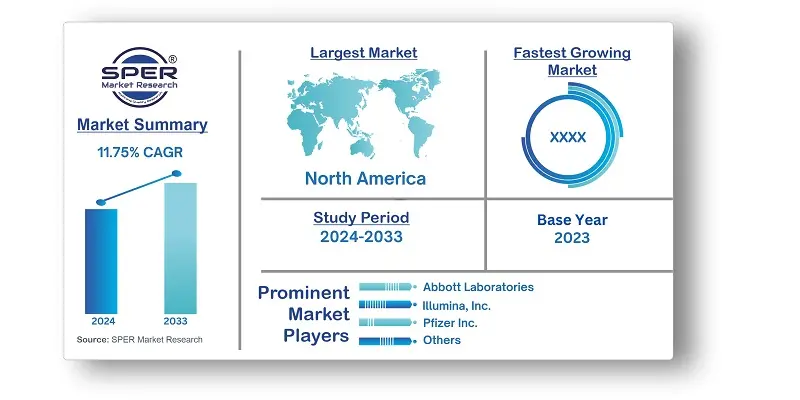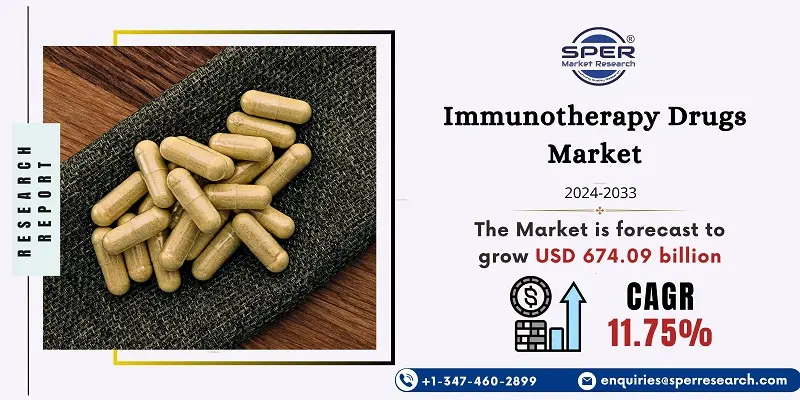
Immunotherapy Drugs Market Trends, Share, Demand, Revenue, Competition and Future Outlook
Immunotherapy Drugs Market Growth, Size, Trends Analysis- By Type of Drug, By Therapy Area, By End User- Regional Outlook, Competitive Strategies and Segment Forecast to 2033
| Published: Oct-2024 | Report ID: PHAR2416 | Pages: 1 - 245 | Formats*: |
| Category : Pharmaceutical | |||
- The safety and tolerability of NC318 as a possible treatment for advanced or metastatic solid tumours would be assessed through a Phase I/II trial (NCT03665285), which NextCure announced will begin in September 2023. The trial comprises evaluations for diseases like ovarian cancer, non-small cell lung cancer, and head and neck squamous cell carcinoma.
- BioNTech SE and the U.K. government signed a Memorandum of Understanding ("MoU") in January 2023 to accelerate clinical studies for tailored mRNA immunotherapies. By the end of 2030, up to 10,000 individuals should be able to receive personalised cancer medicines for their benefit, either through clinical trials or as licensed treatments.


| Report Metric | Details |
| Market size available for years | 2020-2033 |
| Base year considered | 2023 |
| Forecast period | 2024-2033 |
| Segments covered | By Type of Drug, By Therapy Area, By End User. |
| Regions covered | North America, Asia-Pacific, Latin America, Middle East & Africa and Europe. |
| Companies Covered | Abbott, PerkinElmer Inc, Illumina, Inc, QIAGEN, F. Hoffmann-La Roche Ltd, Novartis AG, AstraZeneca, Pfizer Inc, Sanofi, Johnson & Johnson Services, Inc, AbbVie Inc, Allergan. |
- Pharmaceutical and Biotechnology Companies
- Research and Development Institutes
- Hospitals and Specialty Clinics
- Cancer Treatment Centers
- Immunotherapy Drug Manufacturers
- Contract Research Organizations (CROs)
- Government and Regulatory Agencies
- Healthcare Providers and Practitioners
- Investors and Venture Capitalists
- Patient Advocacy Groups
- Health Insurance Providers
- Academic and Medical Research Centers
- Immuno-oncology Specialists
- Contract Manufacturing Organizations (CMOs)
| By Type of Drug: | |
| By Therapy Area: | |
| By End User: |
- Global Immunotherapy Drugs Market Size (FY’2024-FY’2033)
- Overview of Global Immunotherapy Drugs Market
- Segmentation of Global Immunotherapy Drugs Market By Type of Drug (Monoclonal Antibodies, Adult Vaccines, Checkpoint Inhibitors, Interferons Alpha and Beta, Interleukins and Other Drugs)
- Segmentation of Global Immunotherapy Drugs Market By Therapy Area (Cancer, Autoimmune and Inflammatory Diseases, Infectious Diseases and Other Therapy Areas)
- Segmentation of Global Immunotherapy Drugs Market By End User (Hospitals, Clinics and Other End Users)
- Statistical Snap of Global Immunotherapy Drugs Market
- Expansion Analysis of Global Immunotherapy Drugs Market
- Problems and Obstacles in Global Immunotherapy Drugs Market
- Competitive Landscape in the Global Immunotherapy Drugs Market
- Impact of COVID-19 and Demonetization on Global Immunotherapy Drugs Market
- Details on Current Investment in Global Immunotherapy Drugs Market
- Competitive Analysis of Global Immunotherapy Drugs Market
- Prominent Players in the Global Immunotherapy Drugs Market
- SWOT Analysis of Global Immunotherapy Drugs Market
- Global Immunotherapy Drugs Market Future Outlook and Projections (FY’2024-FY’2033)
- Recommendations from Analyst
1.1. Scope of the report1.2. Market segment analysis
2.1. Research data source
2.1.1. Secondary Data2.1.2. Primary Data2.1.3. SPERs internal database2.1.4. Premium insight from KOLs
2.2. Market size estimation
2.2.1. Top-down and Bottom-up approach
2.3. Data triangulation
4.1. Driver, Restraint, Opportunity and Challenges analysis
4.1.1. Drivers4.1.2. Restraints4.1.3. Opportunities4.1.4. Challenges
4.2. COVID-19 Impacts of the Global Immunotherapy Drugs Market.
5.1. SWOT Analysis
5.1.1. Strengths5.1.2. Weaknesses5.1.3. Opportunities5.1.4. Threats
5.2. PESTEL Analysis
5.2.1. Political Landscape5.2.2. Economic Landscape5.2.3. Social Landscape5.2.4. Technological Landscape5.2.5. Environmental Landscape5.2.6. Legal Landscape
5.3. PORTERs Five Forces
5.3.1. Bargaining power of suppliers5.3.2. Bargaining power of buyers5.3.3. Threat of Substitute5.3.4. Threat of new entrant5.3.5. Competitive rivalry
5.4. Heat Map Analysis
6.1. Global Immunotherapy Drugs Market Manufacturing Base Distribution, Sales Area, Product Type6.2. Mergers & Acquisitions, Partnerships, Product Launch, and Collaboration in Global Immunotherapy Drugs Market
7.1. Global Immunotherapy Drugs Market Size, Share and Forecast, By Type of Drug, 2020-20267.2. Global Immunotherapy Drugs Market Size, Share and Forecast, By Type of Drug, 2027-20337.3. Monoclonal Antibodies7.4. Adult Vaccines7.5. Checkpoint Inhibitors7.6. Interferons Alpha and Beta7.7. Interleukins7.8. Other Drugs
8.1. Global Immunotherapy Drugs Market Size, Share and Forecast, By Therapy Area, 2020-20268.2. Global Immunotherapy Drugs Market Size, Share and Forecast, By Therapy Area, 2027-20338.3. Cancer8.4. Autoimmune and Inflammatory Diseases8.5. Infectious Diseases8.6. Other Therapy Areas
9.1. Global Immunotherapy Drugs Market Size, Share and Forecast, By End User, 2020-20269.2. Global Immunotherapy Drugs Market Size, Share and Forecast, By End User, 2027-20339.3. Hospitals9.4. Clinics9.5. Other End Users
10.1. Global Immunotherapy Drugs Market Size and Market Share
11.1. Global Immunotherapy Drugs Market Size and Market Share By Region (2020-2026)11.2. Global Immunotherapy Drugs Market Size and Market Share By Region (2027-2033)11.3. Asia-Pacific
11.3.1. Australia11.3.2. China11.3.3. India11.3.4. Japan11.3.5. South Korea11.3.6. Rest of Asia-Pacific
11.4. Europe
11.4.1. France11.4.2. Germany11.4.3. Italy11.4.4. Spain11.4.5. United Kingdom11.4.6. Rest of Europe
11.5. Middle East and Africa
11.5.1. Kingdom of Saudi Arabia11.5.2. United Arab Emirates11.5.3. Qatar11.5.4. South Africa11.5.5. Egypt11.5.6. Morocco11.5.7. Nigeria11.5.8. Rest of Middle-East and Africa
11.6. North America
11.6.1. Canada11.6.2. Mexico11.6.3. United States
11.7. Latin America
11.7.1. Argentina11.7.2. Brazil11.7.3. Rest of Latin America
12.1. Abbott
12.1.1. Company details12.1.2. Financial outlook12.1.3. Product summary12.1.4. Recent developments
12.2. PerkinElmer Inc
12.2.1. Company details12.2.2. Financial outlook12.2.3. Product summary12.2.4. Recent developments
12.3. Illumina, Inc
12.3.1. Company details12.3.2. Financial outlook12.3.3. Product summary12.3.4. Recent developments
12.4. QIAGEN
12.4.1. Company details12.4.2. Financial outlook12.4.3. Product summary12.4.4. Recent developments
12.5. F. Hoffmann-La Roche Ltd
12.5.1. Company details12.5.2. Financial outlook12.5.3. Product summary12.5.4. Recent developments
12.6. Novartis AG
12.6.1. Company details12.6.2. Financial outlook12.6.3. Product summary12.6.4. Recent developments
12.7. AstraZeneca
12.7.1. Company details12.7.2. Financial outlook12.7.3. Product summary12.7.4. Recent developments
12.8. Pfizer Inc
12.8.1. Company details12.8.2. Financial outlook12.8.3. Product summary12.8.4. Recent developments
12.9. Sanofi
12.9.1. Company details12.9.2. Financial outlook12.9.3. Product summary12.9.4. Recent developments
12.10. Johnson & Johnson Services, Inc
12.10.1. Company details12.10.2. Financial outlook12.10.3. Product summary12.10.4. Recent developments
12.11. AbbVie Inc
12.11.1. Company details12.11.2. Financial outlook12.11.3. Product summary12.11.4. Recent developments
12.12. Allergan
12.12.1. Company details12.12.2. Financial outlook12.12.3. Product summary12.12.4. Recent developments
12.13. Others
SPER Market Research’s methodology uses great emphasis on primary research to ensure that the market intelligence insights are up to date, reliable and accurate. Primary interviews are done with players involved in each phase of a supply chain to analyze the market forecasting. The secondary research method is used to help you fully understand how the future markets and the spending patterns look likes.
The report is based on in-depth qualitative and quantitative analysis of the Product Market. The quantitative analysis involves the application of various projection and sampling techniques. The qualitative analysis involves primary interviews, surveys, and vendor briefings. The data gathered as a result of these processes are validated through experts opinion. Our research methodology entails an ideal mixture of primary and secondary initiatives.



Frequently Asked Questions About This Report
PLACE AN ORDER
Year End Discount
Sample Report
Pre-Purchase Inquiry
NEED CUSTOMIZATION?
Request CustomizationCALL OR EMAIL US
100% Secure Payment






Related Reports
Our Global Clients
Our data-driven insights have influenced the strategy of 200+ reputed companies across the globe.




















